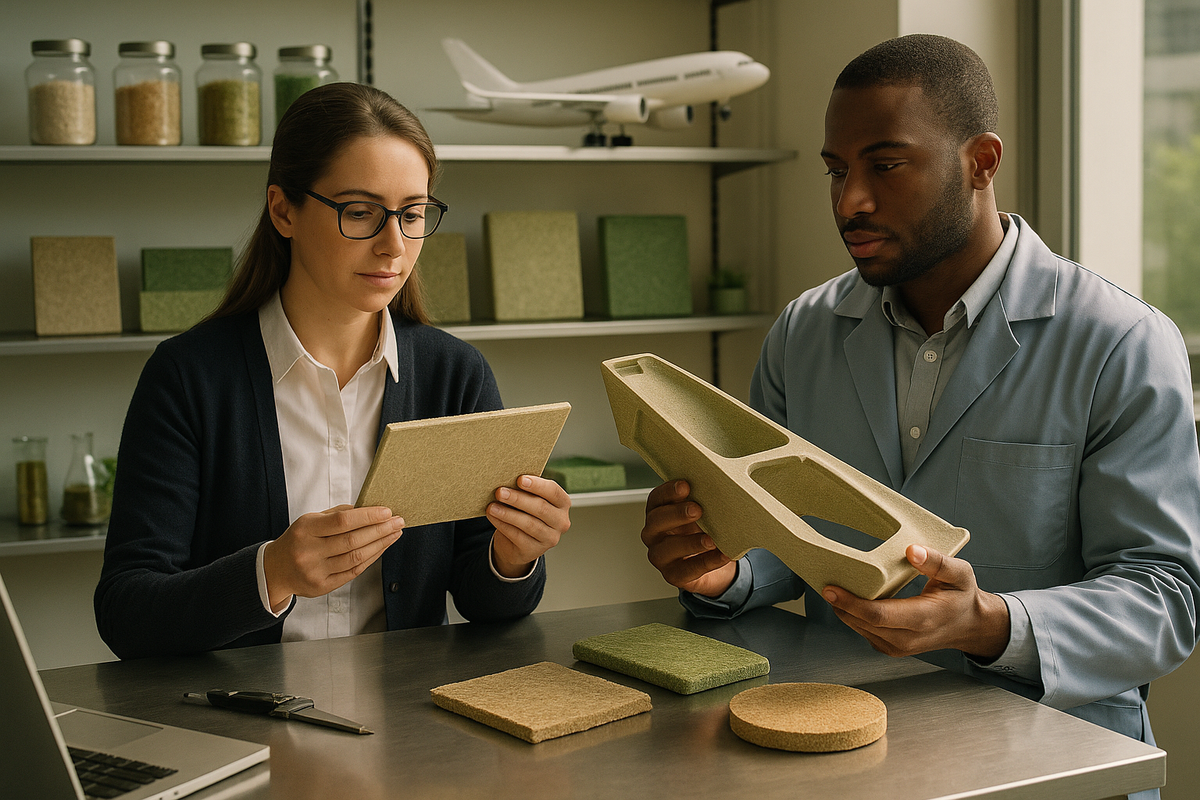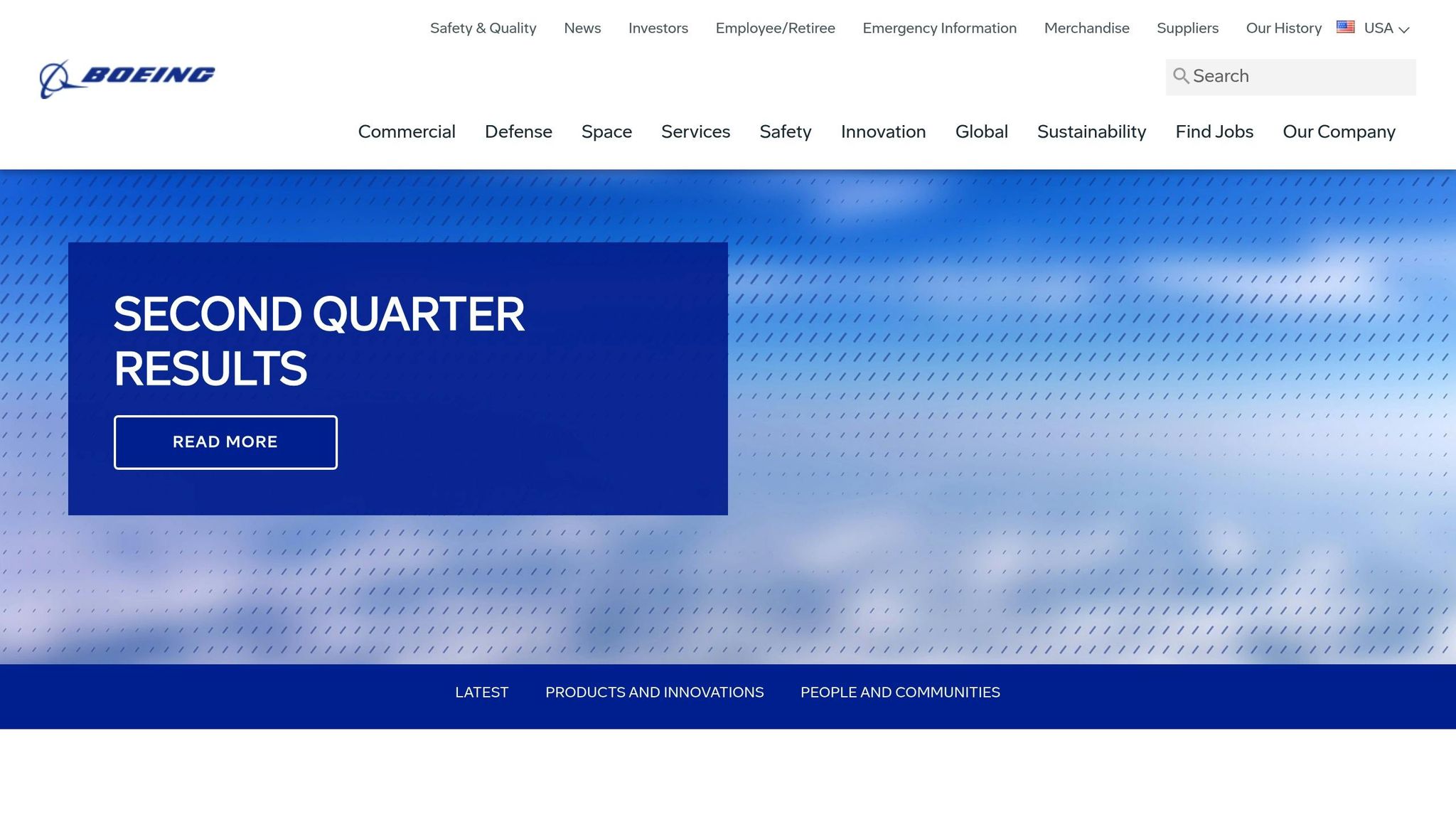Top 5 Aerospace Companies Using Biodegradable Materials
Explore how leading aerospace companies are embracing biodegradable materials to enhance sustainability while meeting strict safety standards.

The aerospace industry is moving toward eco-friendly materials to reduce waste and meet safety standards. Biodegradable and bio-based materials, derived from renewable sources like plant fibers, are being used in cabin interiors, packaging, and non-structural components. These materials decompose naturally and help companies improve their ESG ratings.
Here’s a quick overview of five companies leading this effort:
- Airbus: Uses bio-based polymers (e.g., corn starch) for cabin interiors like seat parts and tray tables, with commercial implementation already underway.
- Boeing: Researching natural fiber composites for cabin and potential structural use, focusing on rigorous testing for safety compliance.
- Safran: Developed bio-based composite panels combining flax fibers and biodegradable resin for interiors, improving weight and insulation.
- Rolls-Royce: Prioritizes advanced composites and recycling, focusing on fuel efficiency rather than biodegradable materials.
- Embraer: Testing bio-based polymers and natural fibers for cabin components in both commercial and executive aircraft.
Key Takeaway: These companies are balancing eco-friendly goals with strict aviation safety standards, signaling a shift in aerospace manufacturing practices.
Sustainability in Aircraft Manufacturing: Trends and Technologies for Composite Materials!
1. Airbus

Airbus is at the forefront of incorporating biodegradable and bio-based materials into its aircraft designs. This aerospace leader is committed to finding eco-friendly alternatives that uphold the strict safety and performance standards required in commercial aviation.
Material Focus
Airbus integrates natural fiber composites and bio-based polymers - like flax, hemp, and recycled carbon fiber - into non-structural components of its aircraft. These materials not only reduce weight but also lessen the environmental impact.
For cabin interiors, Airbus uses bio-sourced thermoplastics derived from renewable resources such as corn starch and sugarcane. These materials deliver the same performance as traditional options while significantly lowering the carbon footprint.
Application Domain
The primary focus for these biodegradable materials is aircraft cabin interiors. Airbus has successfully applied them to various components, including seat parts, overhead bin panels, and decorative finishes. They’ve also been integrated into galley equipment, passenger service units, and other non-load-bearing structures within the cabin.
The A350 aircraft family serves as a testing ground for these sustainable materials. In select configurations, interior panels, armrests, and tray tables now feature bio-based materials that meet stringent fire resistance and durability standards. Beyond cabin interiors, Airbus has adopted biodegradable packaging for aircraft parts during production and delivery, paving the way for broader use of these materials across its operations.
Validation Stage
Airbus has moved beyond the experimental phase, achieving commercial implementation for several biodegradable material applications. The company has conducted rigorous testing and secured regulatory certifications for bio-based components used in passenger cabins.
To ensure consistent quality, Airbus collaborates closely with material suppliers. This partnership guarantees that all biodegradable components meet the necessary standards before receiving final approval for commercial use.
Standards and Requirements
All materials used by Airbus comply with the strict safety and flammability standards set by the FAA and EASA. These include benchmarks for heat release, smoke generation, and toxic gas emissions. Airbus also enforces stringent quality controls to ensure every material meets the demanding requirements of the aviation industry.
In line with its sustainability goals, Airbus incorporates renewable content and plans for end-of-life disposal into its design processes. This commitment ties directly to the broader theme of advancing sustainable innovation in aviation.
2. Boeing

In January 2024, Boeing took a significant step toward greener aviation by starting research into biodegradable materials. This marks a clear move by the aerospace leader toward developing environmentally conscious solutions for the aviation industry.
Material Focus
Boeing's research zeroes in on natural fiber composites and green composites. These materials combine natural fibers with bio-based resins, aiming to meet the rigorous standards required for aerospace applications. The challenge lies in ensuring these composites maintain the necessary structural strength while offering clear environmental advantages over traditional materials. These innovative materials are the foundation of Boeing's efforts to explore their potential across various aircraft applications.
Application Domain
The main focus of Boeing's biodegradable material research is on aircraft interiors, where reducing environmental impact is a priority. The company is actively exploring the use of natural fiber composites in cabin components, such as panels and furnishings. Beyond these interior applications, Boeing is also investigating how green composites could play a role in structural components like aircraft frames and support structures. However, incorporating these materials into critical structural elements requires extensive testing to ensure they meet the demanding conditions of aerospace operations. Current evaluations are focused on understanding how these materials perform under diverse and challenging conditions.
Validation Stage
The journey from concept to commercial use is still underway. Boeing is conducting rigorous tests on green composites, with particular attention to properties like moisture absorption, flammability, and surface durability. These tests are crucial to ensure the materials can withstand extreme conditions while maintaining the safety and reliability standards required in aviation.
Standards and Requirements
Boeing's research is driven, in part, by evolving environmental regulations and the growing demand for sustainable aviation solutions. Any biodegradable materials must not only deliver measurable environmental benefits but also meet or exceed the strict safety requirements of commercial aviation. To achieve this, Boeing employs thorough testing protocols to evaluate how these materials perform in high-stress environments. Like Airbus, Boeing is navigating the challenge of aligning sustainability goals with the uncompromising safety standards of the aviation industry. With increasing pressure to reduce carbon emissions, environmental compliance remains a critical factor in Boeing's material development efforts.
3. Safran

Safran, the French aerospace leader, is making strides in the push for more sustainable aviation solutions. One of its notable achievements is the creation of aircraft interior panels using a bio-based composite. This material combines flax fibers for structural integrity with polylactic acid (PLA) resin, which is biodegradable. By moving away from petroleum-based materials, Safran showcases how biodegradable materials can play a practical role in aviation while reducing environmental impact.
Application Domain
These bio-based composite panels are being used in aircraft interiors, where they bring multiple advantages. They help reduce the overall weight of the aircraft, improve sound insulation, and minimize the environmental footprint over their lifecycle. This approach reflects Safran's dedication to weaving sustainability into aerospace innovation.
4. Rolls-Royce

Rolls-Royce takes a different approach to sustainability compared to companies that incorporate biodegradable materials into cabin components. Instead of focusing on fully biodegradable materials, the company prioritizes improving engine efficiency and recycling advanced materials. While Rolls-Royce doesn't use biodegradable materials in its engine designs or aerospace applications, it actively works on reducing emissions and enhancing sustainability through innovative solutions like high-performance composite materials and sustainable aviation fuels.
Material Innovations
Rolls-Royce has made significant investments in cutting-edge materials such as ceramic matrix composites and carbon fiber-reinforced polymers. These materials are designed to withstand the extreme conditions of jet engines while offering greater durability and improved fuel efficiency compared to traditional metal components. Additionally, the company has implemented titanium recycling programs to minimize waste, aligning with its broader commitment to sustainability.
Focus on Engine Performance
Given the rigorous demands of jet engines, biodegradable materials are not a practical option for core components. Instead, Rolls-Royce channels its efforts into reducing emissions by enhancing engine performance and integrating sustainable aviation fuels into its operations. This focus ensures the company meets performance standards while contributing to a more sustainable future.
5. Embraer

Brazilian aerospace company Embraer is working on incorporating biodegradable materials into aircraft interiors, all while maintaining strict safety and performance requirements.
Material Focus
Embraer is experimenting with bio-based polymers and natural fiber composites for non-critical parts of the cabin, such as seat structures, cabin panels, and decorative elements. The goal? To cut down on weight and lessen the environmental footprint. What's interesting is how Embraer has tailored its testing methods to evaluate these materials differently across their commercial and executive aircraft lines. This unique approach helps ensure the materials perform well under various conditions and prepares them for the necessary regulatory approvals, aligning with the industry's broader shift toward sustainability.
Application Domain and Testing
Early tests in both commercial and executive aircraft suggest these materials can meet the high safety and environmental standards required. Embraer is working hand-in-hand with regulatory authorities to confirm compliance, and initial results indicate that the materials perform up to industry expectations.
Company Comparison Table
Here's a snapshot of how some of the top aerospace companies are incorporating biodegradable materials into their projects:
| Company | Key Initiative |
|---|---|
| Airbus | Developing sustainable materials for aircraft interiors |
| Boeing | Experimenting with biodegradable composites in design |
| Safran | Applying bio-based materials in critical aircraft systems |
| Rolls-Royce | Pioneering advanced composite material innovations |
| Embraer | Testing eco-friendly materials across various aircraft models |
Airbus is focused on enhancing cabin interiors with sustainable options, while Boeing is delving into the potential of biodegradable composites. Safran is working on integrating bio-based materials into essential systems, Rolls-Royce is pushing boundaries with advanced composites, and Embraer is exploring eco-friendly solutions across its aircraft lineup.
Although many of these projects are still in progress, the aerospace industry is clearly making strides in adopting biodegradable materials. This shared effort underscores the sector's dedication to more sustainable design practices and opens the door to exciting advancements in the future of aviation.
Conclusion
Biodegradable materials are changing the game in aerospace strategy. Top companies are weaving these materials into both their systems and cabin designs, signaling a shift in priorities.
This approach is reshaping how aerospace designs and manufactures its products. By focusing on biodegradable composites and bio-based materials, the industry is not only cutting its environmental impact but also finding ways to reduce costs. Companies that jump on this trend early are positioning themselves for a competitive advantage.
The financial implications are just as striking. Investors are increasingly drawn to firms with strong ESG (Environmental, Social, and Governance) credentials. Aerospace companies leading the charge in adopting biodegradable materials are catching the eye of sustainability-focused investment funds. For those keeping an eye on aerospace investments, it’s clear that businesses committed to sustainable practices often deliver stronger long-term performance.
As regulations tighten and consumer demand for greener aviation grows, the adoption of biodegradable materials will only speed up. The companies highlighted here are laying the groundwork for a shift that could make sustainable aviation the norm. This progress is paving the way for a future where the aerospace industry aligns with environmental responsibility.
FAQs
How do biodegradable materials affect aircraft performance and safety in the aerospace industry?
Biodegradable materials in aerospace are crafted to match the demanding safety and performance standards of traditional materials. They need to withstand extreme conditions like rapid temperature changes, intense vibrations, and high-pressure environments - all without sacrificing safety or durability.
To guarantee their reliability, these materials go through extensive testing and certification processes to meet the rigorous regulations of the aerospace industry. Although their use is still developing, these materials are being designed to meet the industry's strict expectations for safety, environmental responsibility, and performance.
What challenges do aerospace companies face when using biodegradable materials in their designs?
Aerospace companies encounter quite a few obstacles when trying to use biodegradable materials in their designs. One of the biggest challenges is making sure these materials can handle the extreme conditions of aerospace environments. We're talking about high temperatures, sudden pressure changes, and intense vibrations - all while ensuring the materials can still break down safely over time.
Another hurdle is ramping up production and tweaking current manufacturing processes to work with these new materials. On top of that, companies have to juggle costs, fine-tune material performance for safety and efficiency, and comply with the industry's strict regulations - all without losing sight of their sustainability goals.
How does using biodegradable materials impact aerospace companies' ESG ratings and investor appeal?
Incorporating biodegradable materials into aerospace manufacturing can make a big difference in improving a company's ESG (Environmental, Social, and Governance) ratings. By minimizing their environmental footprint and showing a clear commitment to sustainability, companies can stand out as leaders in tackling climate challenges and promoting resource efficiency. This can bolster their reputation and resonate with ESG-focused investors who value environmental responsibility.
Beyond reputation, using eco-friendly materials also highlights a company's long-term vision and adaptability, appealing to investors who are drawn to sustainable and innovative businesses. In short, choosing biodegradable materials not only strengthens ESG performance but also builds trust and confidence among environmentally conscious investors.
Comments ()